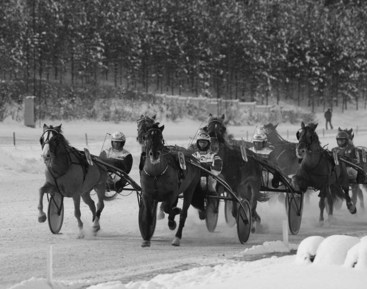Chapter 113The Finnish Horse and Other Scandinavian Cold-Blooded Trotters
Racetracks and Weather Conditions
The racetracks in Scandinavia are 1000-m oval dirt tracks, and the horses race counterclockwise. The climate is cold in the winter, and the tracks freeze and get covered by snow (Figure 113-1). In winter temporary tracks also are made on ice for smaller races with no betting. The variable climate causes track problems. In late autumn when the track is frozen but not yet covered by snow, the surface can be treacherous. Snowfall makes the tracks smooth but not hard, and provided the horse is shod properly, the track is not slippery. In the springtime, when the snow begins to melt, the track conditions vary throughout the day, being hard in the morning after a night frost, becoming good for a few hours when the frost melts, and then becoming wet and soft the rest of the day. Keeping the track in good condition requires much skill.




